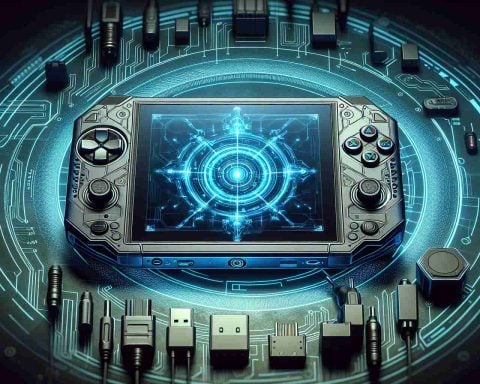- The Switch 2, Nintendo’s next-gen console, promises revolutionary hybrid gaming with cutting-edge technology and creativity.
- A custom NVIDIA Tegra processor with ray tracing elevates visual realism and gameplay across all player demographics.
- An anticipated OLED display enhances handheld gaming with vivid colors and improved contrasts.
- Backward compatibility ensures a seamless transition for existing game libraries, appealing to current Nintendo fans.
- Embracing cloud-based gaming marks Nintendo’s strategic shift, allowing gaming anywhere at any time.
- Environmental and security challenges accompany these technological advancements, necessitating sustainable solutions.
Nintendo is poised to once again shake up the gaming universe with its rumored next-generation console, the Switch 2. Merging state-of-the-art technology with its iconic creativity, this new entry promises to define the future of hybrid gaming.
Game-Changing Graphics: The Switch 2 is expected to sport a custom NVIDIA Tegra processor with ray tracing capabilities, delivering breathtaking visual realism that sets new standards for Nintendo consoles. With this leap in processing power, gamers can anticipate smoother, more immersive gameplay that bridges the gap between casual players and hardcore enthusiasts.
Vibrant Displays: An anticipated OLED screen brings colors to life with richer contrasts, significantly enhancing handheld gameplay experiences. This potentially larger display is set to rival dedicated portable gaming devices, offering a feast for the eyes on the go.
Seamless Transitions: Perhaps one of the most exciting developments is backward compatibility. Players can look forward to carrying over their existing game libraries seamlessly, making the Switch 2 a more inclusive option for existing Nintendo fans.
Cloud Gaming Leap: By embracing cloud-based gaming services, Nintendo aims to redefine its gaming ecosystem. Stream your favorite titles anywhere, anytime, leveraging this innovation that’s already favored by heavyweights like Xbox and PlayStation.
However, as Nintendo ventures into these thrilling opportunities, it also faces challenges. The environmental impact of OLED screens and the implications of widespread cloud gaming must be addressed to ensure this technological marvel is sustainable and secure.
As gaming enthusiasts across the globe buzz with anticipation, one thing is certain: Nintendo’s newest endeavor could transform the way we play, offering a tantalizing glimpse into the future of interactive entertainment.
Nintendo’s Next Big Move: What the Switch 2 Means for Gamers and the Industry
Exploration of Key Aspects of the Nintendo Switch 2
Nintendo is gearing up to revolutionize the gaming industry once more with its anticipated Switch 2. Here’s what we can expect from this next-generation console, along with answers to crucial questions about its impact.
—
How will the graphics and processing power of the Switch 2 compare to current consoles?
Pros and Cons:
– Pros: The Switch 2 is rumored to integrate a custom NVIDIA Tegra processor with ray tracing capabilities, setting a new bar for visual fidelity in Nintendo consoles. This enhancement promises smoother, more immersive gameplay experiences that cater to both casual players and hardcore enthusiasts.
– Cons: Advanced graphics and processing capabilities may lead to increased power consumption, which could affect the battery life in handheld mode.
Trend Insight: With the rise of ray tracing and more realistic graphics in gaming, the Switch 2 could compete more closely with gaming powerhouses like the PS5 and Xbox Series X, making it attractive to a broader audience.
What are the anticipated environmental impacts of the Switch 2’s technology?
Sustainability Concerns:
– While the rumored OLED screens of the Switch 2 promise vibrant visuals and enhanced gameplay, they also raise environmental concerns. OLED technology is associated with significant manufacturing emissions and recycling challenges.
– Industry Trend: As the electronics industry moves towards greener practices, Nintendo might face pressure to develop more sustainable production and recycling processes to minimize its ecological footprint.
Prediction: We can expect further innovations in sustainable materials and processes as consumer demand for eco-friendly products rises, potentially influencing Nintendo’s production strategies.
How does Nintendo’s approach to cloud gaming compare to its competitors?
Market Analysis & Comparisons:
– With the integration of cloud-based gaming services, Nintendo aims to expand its ecosystem, allowing titles to be streamed anywhere. This places Nintendo in direct competition with Xbox’s Cloud Gaming and PlayStation’s PS5 Remote Play, which are already leveraging cloud technology.
– Security Aspects: Cloud services require robust cybersecurity measures to protect player data, which Nintendo must prioritize as it scales its online offerings.
Use Cases: This expansion could increase accessibility and playability, enabling gaming across multiple devices without needing physical hardware.
Comparison: While Nintendo has been slower to adopt cloud services compared to competitors, its focus on hybrid gaming may offer a unique angle that emphasizes mobility and convenience for its dedicated player base.
—
For further insights into Nintendo’s strategic moves and the gaming console landscape, visit Nintendo.
—
As we anticipate the arrival of the Switch 2, these revelations highlight a transformative period not just for Nintendo but for the entire gaming world. Embracing cutting-edge technology and sustainable practices will be crucial in shaping the future of gaming.




















